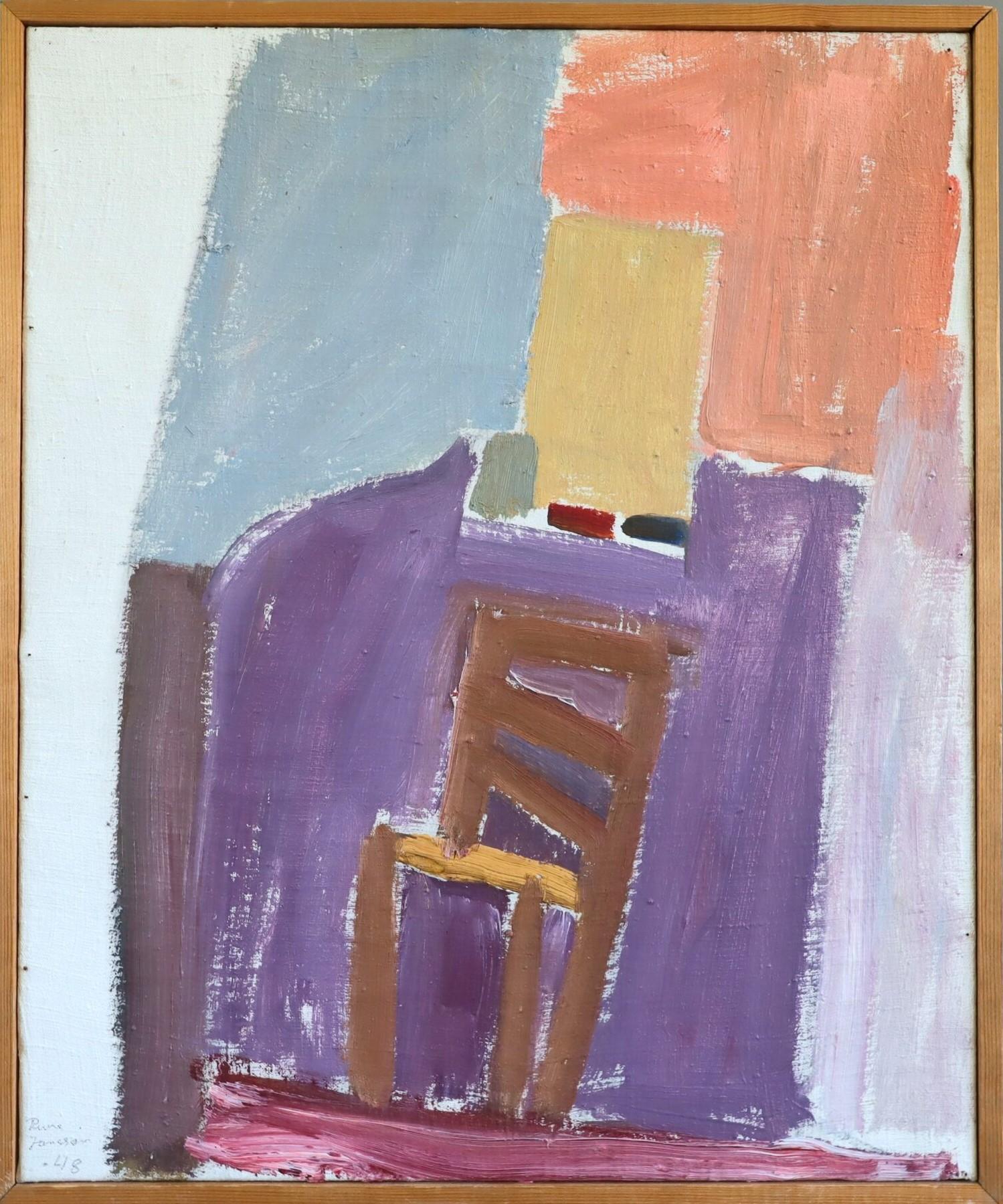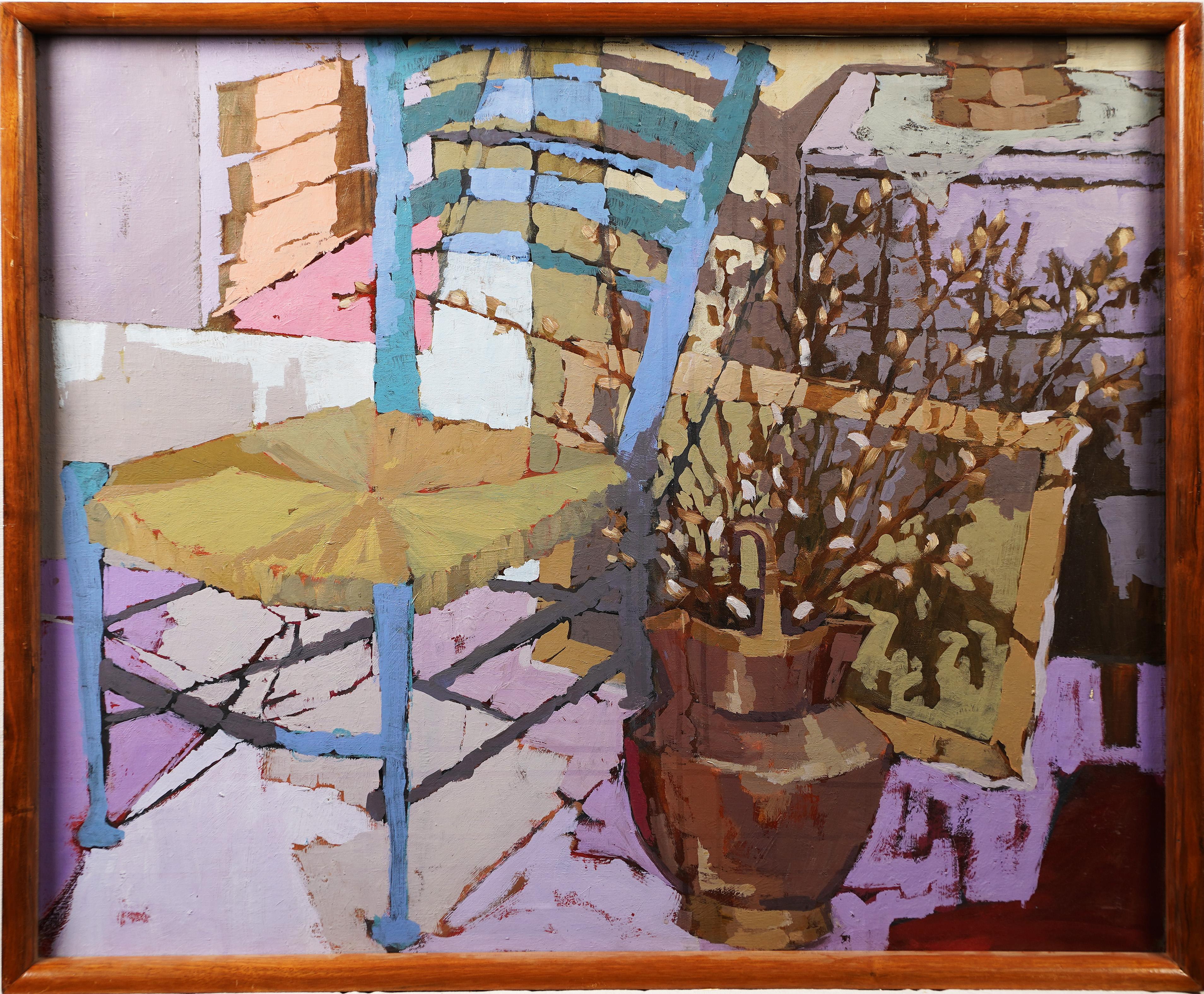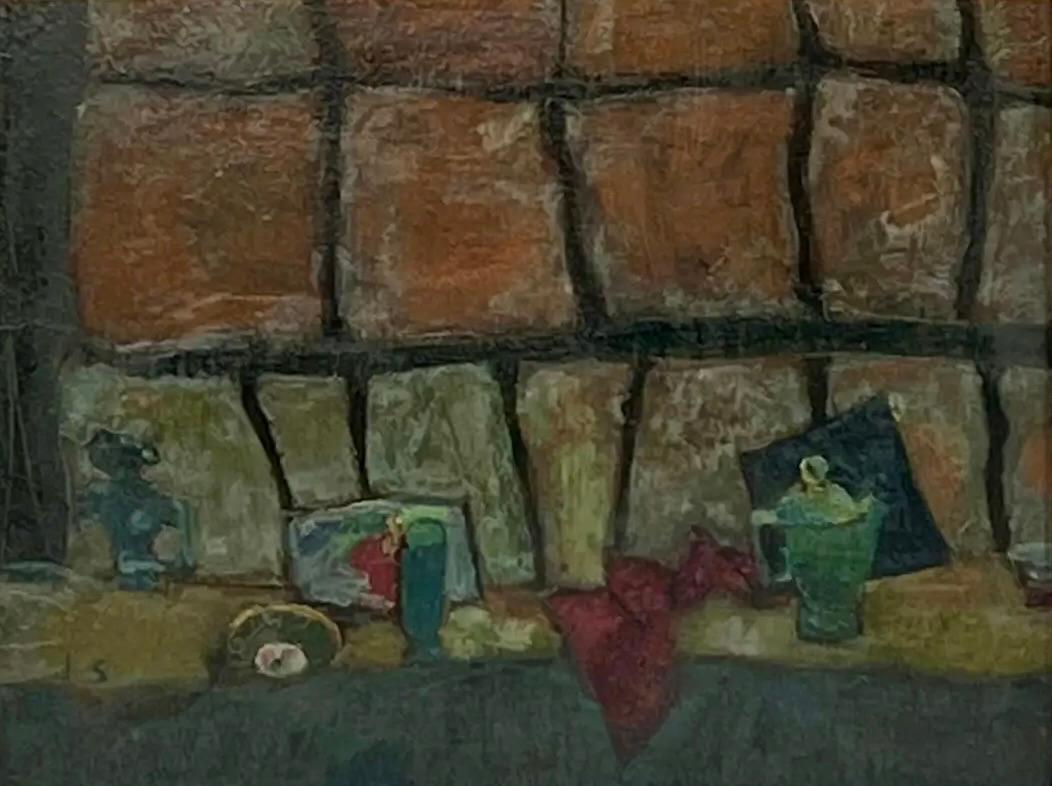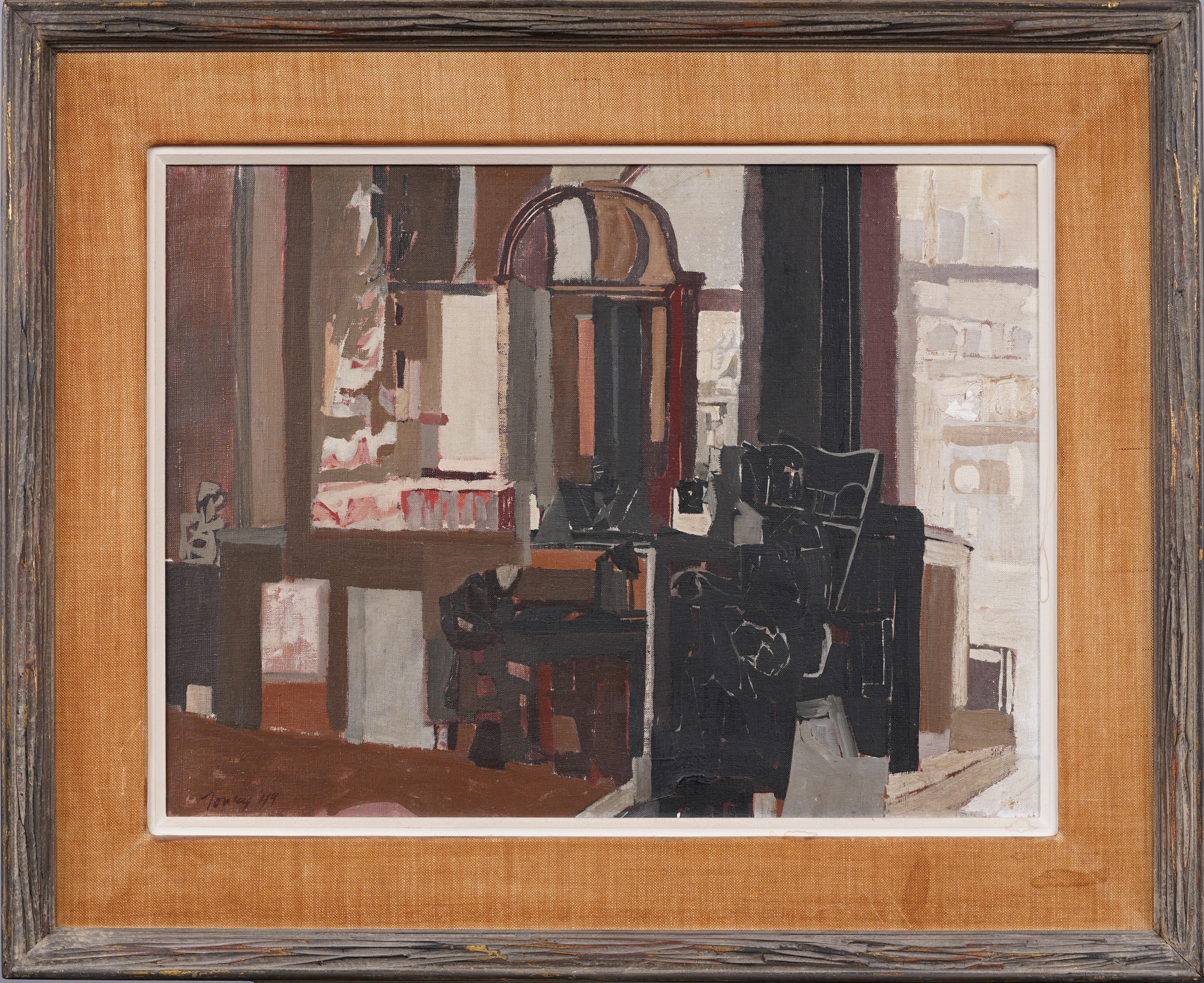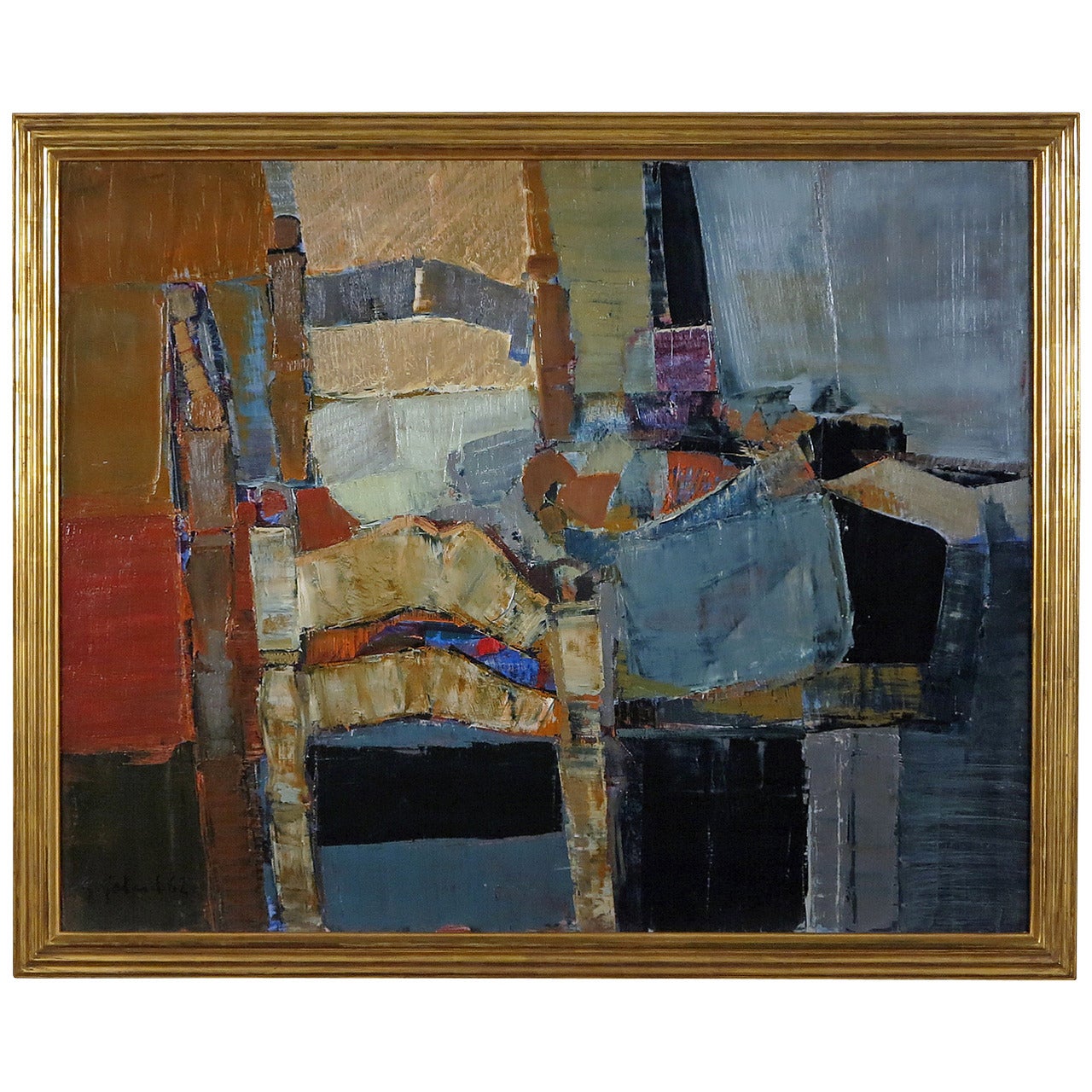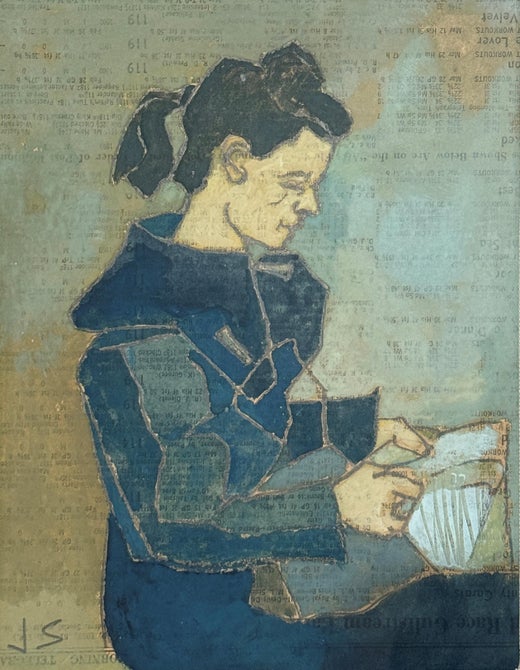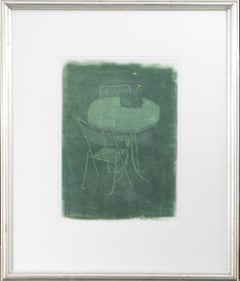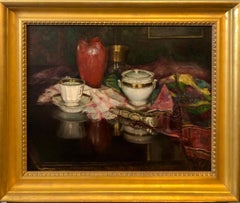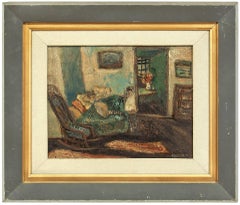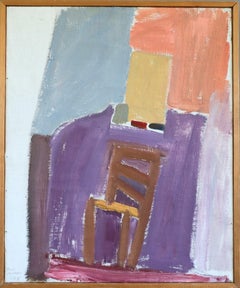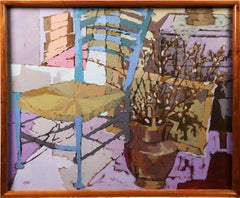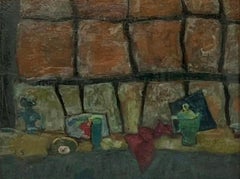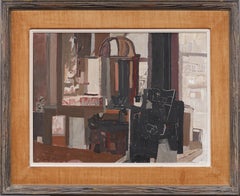Items Similar to Oil Painting Interior Scene Chair w Chinese Rug Joseph Solman American Art WPA
Want more images or videos?
Request additional images or videos from the seller
1 of 12
Joseph SolmanOil Painting Interior Scene Chair w Chinese Rug Joseph Solman American Art WPA
$9,500
£7,208.38
€8,242.14
CA$13,268.92
A$14,753.24
CHF 7,703.33
MX$179,582.83
NOK 98,291.10
SEK 92,094.06
DKK 61,512.60
Shipping
Retrieving quote...The 1stDibs Promise:
Authenticity Guarantee,
Money-Back Guarantee,
24-Hour Cancellation
About the Item
Joseph Solman (1909-2008),
Chair with Chinese Rug,
oil paint on masonite, initialed JS on recto, titled and signed "J.S." verso,
Dimensions 14" x 10" Framed to 21 X 17
Provenance: William H. Trayes, Jr. art collection
Joseph Solman (January 25, 1909 – April 16, 2008) was a Jewish American painter, a founder of The Ten, a group of New York City Expressionist painters in the 1930s. His best known works include his "Subway Gouaches" depicting travellers on the New York City Subway.
Born in Vitebsk, Belarus, Russian Empire, he was brought to America from the Russian Empire as a child in 1912, Solman was a prodigious draftsman and knew, in his earliest teens, that he would be an artist. He went straight from high school to the National Academy of Design, though he says he learned more by sketching in the subway on the way back from school late at night: people "pose perfectly when they're asleep." In 1929, Solman saw the inaugural show at the Museum of Modern Art featuring Seurat, Gauguin, Van Gogh, and Cézanne.
In 1934, Solman had his first one-man show, much influenced by the French modern artist Georges Rouault. One critic was impressed by "the mystery that lurks in deserted streets in the late twilight." Another noted that Solman's color had "an astonishingly rich quality that burns outward beneath the surface."
Joseph Solman was, with Mark Rothko, the unofficial co-leader of The Ten, a group of expressionist painters including Louis Schanker, Adolph Gottlieb, Ben Zion and Ilya Bolotowsky, who exhibited as the "Whitney Dissenters" at the Mercury Galleries in New York City in 1938. The members, all immigrant Jewish New Yorkers with an interest in European Expressionism, presented an urban, abstract, formal style. A champion of modernism, Solman was elected an editor of Art Front Magazine when its other editors, art historian Meyer Schapiro and critic Harold Rosenberg, were still partial to Social Realism. But Solman never believed in abstraction for abstraction's sake. "I have long discovered for myself," Solman has said, "that what we call the subject yields more pattern, more poetry, more drama, greater abstract design and tension than any shapes we may invent." As his colleagues in the Ten advanced toward a more non-objective art, Solman warmed toward representation. An artist in the Works Project Administration (WPA) during the depression, Solman met and worked with and befriended many great artists, like Milton Avery. “Avery had a big influence on me when I was young and working in the WPA,” said Solman. “That was a great program, I couldn’t have worked without it. It’s where I saw Paul Klee’s work, which I liked very much.” By the early 1950s, when the Abstract Expressionism he had helped to develop was the mainstream in avant garde art, he was done with it. With Edward Hopper and Jack Levine, he began a magazine called "Reality." It featured the work of figurative painters, then terribly out of fashion, but its central editorial stance was that artists should be able to paint however and whatever they liked. In writing about a purchase of a typical 1930s Solman street scene for the Wichita Museum, director Howard Wooden put it this way: "Solman has produced the equivalent of an abstract expressionist painting a full decade before the abstract expressionist movement came to dominate the American art scene, but without abandoning identifiable forms." He was part of a group of New York mostly jewish artists that included Byron Browne, Milton Avery, Stuart Davis, Alice Neel, Max Weber, Ben Shahn and many others.
In 1964, The Times, discussing his well-known subway gouaches (done while commuting to his some-time job as a racetrack pari-mutuel clerk), called him a "Pari-Mutuel Picasso." In 1985, on the occasion of a 50-year retrospective, The Washington Post wrote: "It appears to have dawned, at last, on many collectors that this is art that has already stood the acid test of time.
- Creator:Joseph Solman (1909-2008, American)
- Dimensions:Height: 21 in (53.34 cm)Width: 17 in (43.18 cm)
- Medium:
- Movement & Style:
- Period:
- Condition:good. measurements include frame, mat and frame have wear and can use replacing.
- Gallery Location:Surfside, FL
- Reference Number:1stDibs: LU38214033612
Joseph Solman
Brought to America from Russia as a child in 1912, Joseph Solman was a prodigious draftsman and knew, in his earliest teens, that he would be an artist. He went straight from high school to the National Academy of Design, though he says he learned more by sketching in the subway on the way back from school late at night: people “pose perfectly when they’re asleep.” In 1929, Solman saw the inaugural show at the Museum of Modern Art featuring Seurat, Gauguin, Van Gogh, and Cezanne. It changed his life – and his art. Joseph Solman was, with Mark Rothko, the unofficial co-leader of The Ten, a group of expressionist painters who exhibited as the “Whitney Dissenters” at the Mercury Galleries in New York in 1938. A champion of modernism, Solman was elected an editor of Art Front Magazine when its other editors, art historian Meyer Shapiro and critic Harold Rosenberg, were still partial to Social Realism In 1964, The Times, discussing his well-known subway gouaches (done while commuting to his some-time job as a racetrack pari-mutuel clerk), called him a “Pari-Mutuel Picasso.” In 1985, on the occasion of a 50-year retrospective, The Washington Post wrote: “It appears to have dawned, at last, on many collectors that this is art that has already stood the acid test of time.” We had the pleasure of the meeting the artist a few times at his home which was over the original Second Avenue Deli in the East Village.
About the Seller
4.9
Platinum Seller
Premium sellers with a 4.7+ rating and 24-hour response times
Established in 1995
1stDibs seller since 2014
1,784 sales on 1stDibs
Typical response time: <1 hour
- ShippingRetrieving quote...Shipping from: Surfside, FL
- Return Policy
Authenticity Guarantee
In the unlikely event there’s an issue with an item’s authenticity, contact us within 1 year for a full refund. DetailsMoney-Back Guarantee
If your item is not as described, is damaged in transit, or does not arrive, contact us within 7 days for a full refund. Details24-Hour Cancellation
You have a 24-hour grace period in which to reconsider your purchase, with no questions asked.Vetted Professional Sellers
Our world-class sellers must adhere to strict standards for service and quality, maintaining the integrity of our listings.Price-Match Guarantee
If you find that a seller listed the same item for a lower price elsewhere, we’ll match it.Trusted Global Delivery
Our best-in-class carrier network provides specialized shipping options worldwide, including custom delivery.More From This Seller
View AllMonotype Print Painting Garden Scene Table Chair Joseph Solman American Art WPA
By Joseph Solman
Located in Surfside, FL
Monotype Painting Title: Table and Chairs, 1980
Medium: monotype or monoprint painting
Size: image 13 x 9.5,overall with frame 23 x 20
Hand signed and dated lower right
Provenance...
Category
20th Century Modern More Art
Materials
Monotype
1925 Viennese Oil Painting Interior Still Life with Porcelain Vase, Tapestry Rug
Located in Surfside, FL
Framed 21.2 X 25.5
Unframed 17 X 21
Signed and dated 1920.
Nina Karasek (Joële)
born 1883 Kuttenberg, Czech Lands, Austro-Hungarian Empire, died in 1952 (I have also seen the date recorded as 1933) Vienna, Austria. Nina Karasek was an Austrian Impressionist & Modern artist who was born in 1883. Her work was featured in exhibitions at the Es Baluard, Museum of Modern & Contemporary Art and the Bildraum Bodensee.
Little is known of Nina Karasek's life. She was born in 1883 in Kuttenberg (Kutná Hora) in Bohemia, studied art at the Kunstschule für Frauen und Mädchen (Art School for Women and Girls) in Vienna, Austria, under Adalbert Seligmann and Tina Blau. She studied at the Frauenakademie in Vienna and Munich. In the 1920's she worked first as a landscape painter and an illustrator, later turning toward symbolism, painting mystical subjects after her interest in spiritualism. Her conventional works were shown at various exhibitions. At the age of 44, while she was copying a work by Rembrandt in an Italian museum, she fell into an altered state of consciousness. Rembrandt appeared to her, took possession of her arm, and immediately her hand started to draw something quite different from what she had intended. From then on, for the rest of her life Nina Karasek was in “supernatural” contact with a series of great masters like Rembrandt, Albrecht Dürer, Goya, Raphael, Leonardo da Vinci, Gustav Klimt and others. Under their guidance and inspiration, she drew and painted works "in the style" of the masters. But very soon her works became stylistically more and more unrestricted and Symbolist, showing an enormous range of creative expression, ranging from symbolic and allegorical motifs to bewildering images with a fantastic arsenal of figures and private characters, signs, and symbols, and to frantic, gestural sketches and abstract compositions. From then on, she often signed her works with her esoteric “primordial name” Joële. (Nina Karasik-Joel)
Almost everything we know about her life was from what she noted on the reverse of her drawings: sometimes diary-like notes of her horrible living conditions during World War II, but often strangely impenetrable explanations of the depicted motifs – often as fascinating and mysterious as the drawings themselves. In her works and notes, an exciting private cosmology and mythology unfolds, a drama of hidden powers and principles that flow through macrocosm as well as microcosm. Shortly after their discovery, Nina Karasek's Spiritualist, mediumistic works have found their way into galleries and major international collections.
SELECT EXHIBITIONS
2019 The Medium’s Medium: Spiritualist Art Practices From the Turn of the Century and Beyond. The Gallery of Everything, London, (she showed with Madge Gill, Augustin Lesage, Fleury-Joseph Crépin...
Category
1920s Symbolist Interior Paintings
Materials
Canvas, Oil
Abstract Interior Scene
By Abram Tromka
Located in Surfside, FL
Measures 16.5 X 20 without frame. heavy craquelure. it seems like some sort of experimental technique the artist used. paint is stable. please see photos Abram Tromka was born May 1, 1896 in Poland. At the age of seven he immigrated with his family to the United States, settling in New York City. It was on the boat coming to New York where Tromka first became interested in art. Fascinated by a woman who was painting, he decided that he wanted to become an artist. Upon arrival at immigration headquarters, Tromka’s family adopted the surname “Phillips,” which he kept until 1930. Hence the artist’s early works bear the signature — ‘A. Phillips.’
Having a rough childhood, Tromka left home at 15 and spent the remainder of his teenage years living at the Henry Street...
Category
20th Century Modern Abstract Paintings
Materials
Oil, Board
Seated Man Portrait, Large Modernist Oil Painting WPA Artist
By Nahum Tschacbasov
Located in Surfside, FL
Nahum Tschacbasov was born in Baku, in the southeast of Russia. When he was eight years old, he came to America, where his family settled in Chicago.
His career, spanning more than five decades from the 1930’s to the 1980’s, is a kaleidoscope of influences, from modernism to the Byzantine style and expressionism of his Russian roots.
Tschacbasov’s paintings of the 1930’s reflect the social and political preoccupations of the times. He received considerable critical attention for his powerful dramatic satirical depiction of social injustice.
In the 1940’s he gained wider recognition when his style evolved into a fusion of Cubism and Surrealism. Through the influence of Jung, as well as currents brought to America by the newly arrived group of European Surrealists, he created a powerful personal iconography in which the inner workings of the psyche are revealed as myth and metaphor.
His first encounters with modern art are the works of Cezanne, Van Gogh, and Rouault. 1932-33 Tschacbasov moves for a short time to New York City in order to be in a modern art center and then to Paris, where he adopts the name Tschacbasov, an anagram of different family names. He studies with Leopold Gottlieb for eight months, then with Marcel Gromaire, who teaches him pictorial structure, and briefly with Fernand Leger. Working in his studio on the edge of Montmartre and later in the Hotel de Sante in Montparnasse, he produces a large body of work, retaining fifty paintings. After trips to North Africa, Spain, and the Balearic Islands, he travels often from Paris to New York City, where he spends six months painting a series of Depression-inspired pictures after finding that his American business has gone bankrupt in his absence. 1934 In Paris, Galerie Zak exhibits landscapes from his trip to Majorca in the first one-man exhibition of Tschacbasov paintings; Salon de Tuileries also exhibits his work. His savings exhausted, he returns to New York via Tunisia in the midst of the Depression. 1935 Living on Pineapple Street in Brooklyn Heights, Tschacbasov works on the WPA Federal Arts Project, Easel Division, where he meets other artists and becomes politically involved. His works are shown at Galerie Secession with those of Mark Rothko, Adolph Gottlieb, and other modernist and expressionist painters. Tschacbasov, Rothko, Gottlieb, Joseph Solman and others from Galerie Secession form a group called The Ten combining common aims of social consciousness with an expressionist and abstract style. Themes of social injustice are more dominant in Tschacbasov's work than in that of others of The Ten, as he draws on his own childhood experiences of the harsh realities of immigrant life in industrial Chicago. In the summer, a one-man exhibition of his non-objective paintings is held at Galerie Secession, and in December, Montross Gallery in New York City holds the first exhibition of The Ten, including two works by Tschacbasov, "Handout" and "Three Graces." 1936 In January, an exhibition of The Ten is held at Municipal Art Galleries in New York City, and later in the fall an exhibition, also of The Ten, is held at Galerie Bonaparte in Paris. 1936-38 Among the paintings exhibited in the "Annual Exhibition of Contemporary American Painting" at the Whitney Museum of American Art are Tschacbasov's "Deportation", "Clinic", "Friday Night", "Harbor Sunset", and "The Matriarch". 1936-37 Tschacbasov is appointed business manager of Art Front Magazine, a publication associated with the Artists' Union. His circle of friends at this time include Philip Evergood, Milton Avery, Stuart Davis, David Burliuk, William Gropper, the Soyer brothers, Robert Gwathmey, Marsden Hartley, and Max Weber. Due to cut-backs in WPA funding, he teaches at his 38 West 22nd Street studio and at the American Artists' School. On the faculty are David Burliuk and the Soyer brothers, as well as Elaine de Kooning and other artists with similar aesthetic and social points of view. Personal and artistic crises lead to his entering into Jungian psychoanalysis, which provides new impetus and direction to his painting. Under the influence of analysis, he starts to write portions of a surrealistic autobiography, The Moon is My Uncle. His paintings, "Refugees" and "Friday Night" are shown with works by Avery, Burliuk, and DeHirsh Margules in a group exhibition at Albright Art Gallery in Buffalo, New York. In September, the Berkshire Museum in Pittsfield, Massachusetts focuses on themes of social criticism in an exhibition entitled "The World Today", curated by Elizabeth McCausland, which includes Tschacbasov's, "Little Red School House". 1940 Tschacbasov takes up photography. Photographing the works of friends and other artists, he builds a collection of color slides...
Category
1940s Modern Figurative Paintings
Materials
Canvas, Oil
Mid Century Mothers, Children Oil Painting Frank Kleinholz WPA Era NYC Tenements
By Frank Kleinholz
Located in Surfside, FL
Frank Kleinholz (Brooklyn, 1901 - 1987)
Mothers with children oil on canvas painting
Frame: 27 X 23
Image: 17.75 X 13.75
Born in Brooklyn, New York, Frank Kleinholz was a painter b...
Category
20th Century Abstract Figurative Paintings
Materials
Canvas, Oil
Post Impressionist Oil Painting Still Life with Fruit William Meyerowitz WPA Art
By William Meyerowitz
Located in Surfside, FL
William Meyerowitz (1887 - 1981)
Oil painting on canvas
Depicting a still life scene with fruit bowl, bananas, flowers and quilt. Post Impressionist oil painting.
Hand signed low...
Category
1930s American Modern Figurative Paintings
Materials
Oil, Canvas
You May Also Like
1948 Mid Century Modern Swedish Interior Scene Oil Painting - Chair by the Wall
Located in Bristol, GB
CHAIR BY THE WALL
Size: 42 x 35 cm (including frame)
Oil on canvas
A striking mid-century modernist style composition of an interior scene, executed in oil onto canvas and dated 194...
Category
Mid-20th Century Modern Interior Paintings
Materials
Canvas, Oil
Vintage American Modernist Abstract Interior Scene Framed Oil Painting
Located in Buffalo, NY
Antique American modernist interior scene oil painting. Oil on canvas. Framed.
Category
1940s Modern Abstract Paintings
Materials
Canvas, Oil
$1,196 Sale Price
20% Off
Studio Interior Mid 20th Century American Scene Modern WPA Still Life Realism
By Joseph Solman
Located in New York, NY
Studio Interior Scene Mid 20th Century American Modern WPA Still Life Realism
The painting measures 10 x 12 inches. Framed, the work is 13 1/4 x 15 1/...
Category
1930s American Realist Interior Paintings
Materials
Oil, Board
Antique American Modernist Interior Scene Framed Abstract Signed Oil Painting
Located in Buffalo, NY
Incredible early American modernist interior scene by Anthony Toney (1913 - 2004) . Oil on canvas. Framed. Signed. Measuring 26 by 32 overall and 18 by 24 painting alone.
Category
1940s Abstract Abstract Paintings
Materials
Canvas, Oil
$1,400 Sale Price
20% Off
Vintage Mid-Century Modern Original Oil Painting - Still Life with White Chair
Located in Bristol, GB
STILL LIFE WITH WHITE CHAIR
Oil on Canvas
Size: 64 X 74 cm (including frame)
A soothing mid-century modernist style still life composition, executed in oil onto canvas.
The paintin...
Category
Late 20th Century Modern Still-life Paintings
Materials
Oil, Canvas
Aux Chaise by Gabriel Godard, Oil on Canvas Painting
By Gabriel Godard
Located in Sheffield, MA
Gabriel Godard.
French, born 1933.
Aux Chaise.
Oil on canvas:
29 by 36 in. with frame 33 by 40 in.
Signed lower left and dated 62.
Gabriel Godard was born on April 28, 1933 in Delo...
Category
Vintage 1960s French Paintings
Materials
Canvas
More Ways To Browse
Painting Chinese Man
Joseph Mayer
New York Wpa Painting
French Empire Paintings
Oil Painting Of George Washington
Vintage Chinese Oil Painting
Avery Milton
Russian Empire Painting
20th Century Oil Paintings China
Oil Painting By Alice
Wpa Styled Oil Paintings
French Street Scene 1950s
Chinese Gouache Painting
Oil Paintings Of Jewish Man
Chair 1912
Howard Post Painting
French Masonite Paintings
J Davis
